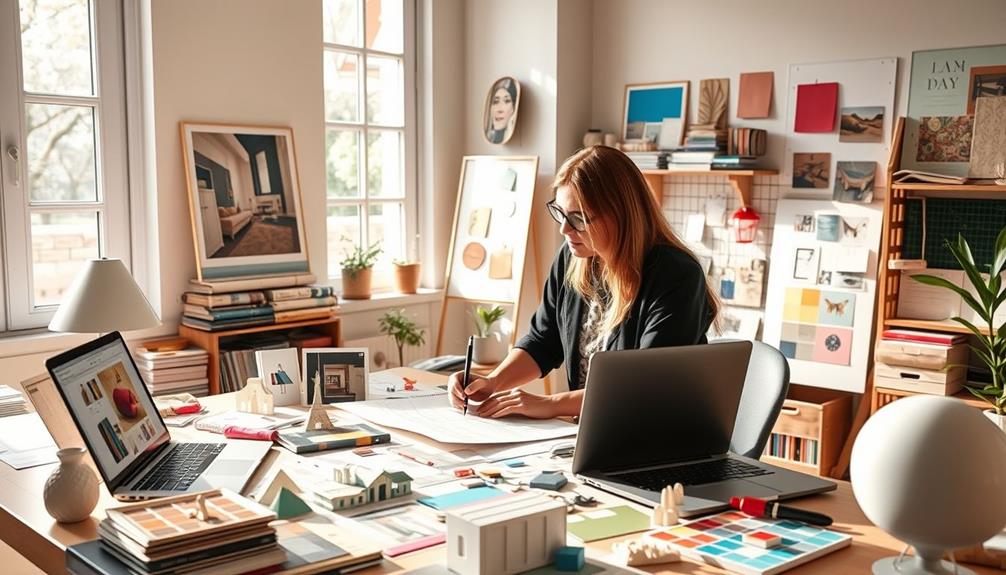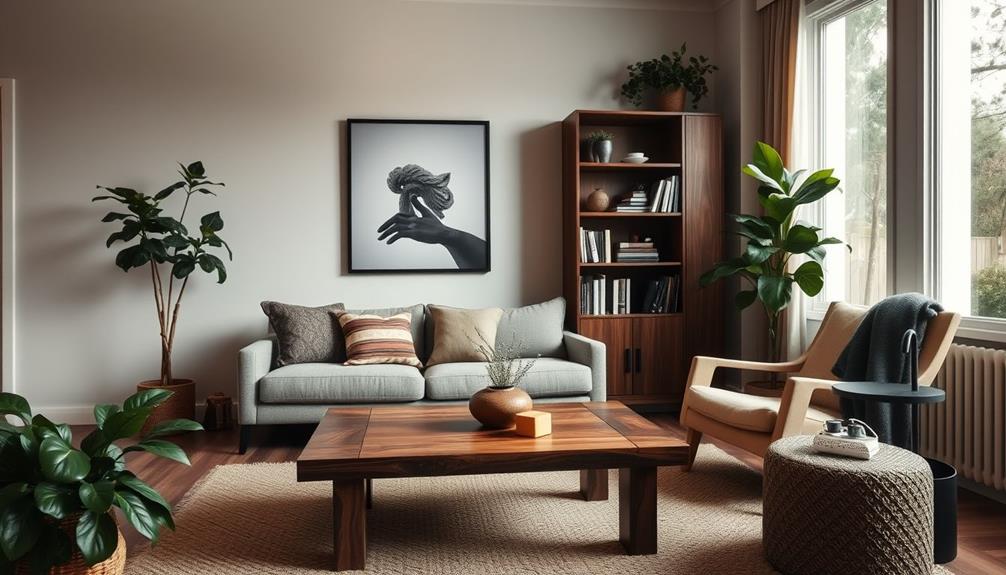To work in interior design, you'll need a mix of creativity and technical skills. Start by evaluating your interests and deciding if you prefer residential or commercial spaces. Pursue a degree in interior design, as you'll gain essential knowledge in design theory and software. Don't forget to complete an internship to build your portfolio and enhance your job prospects. Focus on mastering both hard skills, like CAD software, and soft skills, such as communication. Networking with industry professionals is vital, too. With these steps, you'll lay a strong foundation for your career, and there's much more to explore on this journey.
Key Takeaways
- Assess your interests and goals to determine if you prefer residential or commercial interior design.
- Obtain a relevant degree and complete the NCIDQ exam for certification and licensing.
- Develop essential hard skills, including proficiency in design software and project management.
- Build a professional network by joining associations and attending industry events.
- Stay updated on design trends and sustainable practices through publications and workshops.
Self-Assessment and Career Preparation

Self-discovery is crucial in carving out a successful career in interior design. Begin with self-assessment to evaluate your design skills and interests. Distinguishing between the roles of interior decorators and designers helps you find your passion in the field.
Consider whether you prefer residential or commercial spaces, as this can shape your career preparation. Set both short- and long-term career goals to guide your journey.
Explore diverse paths, like working in design firms, project management, or materials sales. Engage in internships and seek practical experience before graduation; they're essential for building a strong portfolio of your work and enhancing your job prospects.
Joining professional associations is another key step. These networks provide valuable insights, opportunities, and connections that support your career development in interior design.
Surrounding yourself with industry professionals can inspire you and open doors, making your change into the field smoother.
Education and Certification Requirements

To succeed in interior design, you'll need to explore various degree options that meet industry standards.
Understanding the licensing and certification process is essential, as it often involves passing the NCIDQ exam and completing internships for hands-on experience.
These steps won't only enhance your skills but also greatly improve your job prospects in the competitive field of interior design.
Degree Options Available
Exploring your options in interior design education is essential for building a successful career in this creative field. You have a couple of degree options to evaluate: a bachelor's degree in interior design or an associate's degree in interior design.
A bachelor's degree typically requires four years of study, covering critical topics like design theory, color theory, and computer-aided design (CAD) software. This thorough education prepares you for advanced roles in the industry. On the other hand, an associate's degree offers a quicker two-year path, providing foundational skills for entry-level positions or further education.
Here's a quick comparison of the degree options:
| Degree Type | Duration | Key Focus Areas |
|---|---|---|
| Bachelor's Degree in Interior Design | 4 years | Design theory, color theory, CAD |
| Associate's Degree in Interior Design | 2 years | Foundational skills, basic design principles |
| NCIDQ Exam Requirement | Yes | Requires a degree + supervised work experience hours |
| Accreditation | CIDA | Enhances job opportunities |
Don't forget about continuing education through workshops and seminars to keep your skills fresh and meet licensing requirements.
Licensing and Certification Process
Once you've chosen the right degree in interior design, the next step is steering through the licensing and certification process. To become a licensed interior designer, you'll typically need a bachelor's degree in interior design from a program accredited by the Council for Interior Design Accreditation (CIDA). This involves about four years of formal education.
Most states require you to pass the National Council for Interior Design Qualification (NCIDQ) exam, which consists of three parts: the IDFX (Interior Design Fundamentals Exam), the IDPX (Interior Design Professional Exam), and a practicum section focused on design application and ethics.
To be eligible for the NCIDQ exam, you'll need to meet specific work experience requirements, usually around two years, along with your formal education.
Keep in mind that some states may have additional licensing requirements, so it's vital to research the specific regulations for the state where you plan to practice.
Obtaining your interior design certification not only enhances your credibility but also opens doors to opportunities within design firms. Continuous professional development is essential to stay updated in this dynamic field.
Importance of Internships
Internships play an essential role in your journey toward a successful career in interior design. They provide invaluable real-world experience, allowing you to apply the concepts learned in your interior design education. Many states mandate a specific number of internship hours supervised by a licensed designer before you can qualify for the NCIDQ exam, which is critical for certification and licensing.
A well-structured internship enables you to build a robust professional portfolio, showcasing your skills through actual projects. This portfolio is vital for impressing future employers and demonstrating your creativity.
Additionally, participating in internships fosters networking opportunities with established designers, opening doors to job opportunities and mentorship that can greatly impact your career.
Research shows that students who complete internships are more likely to secure employment after graduation, as practical experience boosts your job readiness and marketability.
By engaging in internships, you not only enhance your understanding of the industry but also position yourself as a competitive candidate in the job market.
Essential Skills and Competencies

As you step into the world of interior design, mastering both hard and soft skills is essential for your success.
You'll need technical expertise in design software and a solid grasp of materials, but don't underestimate the power of strong communication and problem-solving abilities.
Balancing these skills will help you meet client needs and navigate complex projects effectively.
Hard Skills Required
In interior design, mastering a variety of hard skills is essential for your success. Proficiency in design software like AutoCAD, SketchUp, and Revit is critical for creating detailed design plans and 3D models that accurately represent your vision.
You'll also need strong problem-solving skills to tackle design challenges and optimize interior spaces while guaranteeing they meet your clients' needs. A solid understanding of color theory is important, too, as it helps you create harmonious color palettes that enhance the aesthetic appeal of each project.
Additionally, project management skills, including budgeting and timeline management, are fundamental for overseeing design projects from conception to completion. Familiarity with building codes and safety regulations guarantees compliance and the successful execution of your design plans.
Technical knowledge of various materials and construction techniques will also empower you to make informed decisions that elevate your designs. Finally, mastering space planning is key to maximizing functionality and flow within interior spaces, allowing you to deliver practical and beautiful solutions.
Soft Skills Importance
While hard skills like design software proficiency and project management are vital for interior designers, soft skills play an equally significant role in your success. These skills not only enhance your effectiveness but also contribute to client satisfaction and the overall success of your projects.
Here are four key soft skills you should cultivate:
- Communication and Interpersonal Skills: Clear communication guarantees that project goals are understood by clients and teams, fostering collaboration.
- Attention to Detail: This skill is essential for accurately interpreting client needs and executing precise design elements, ultimately affecting project quality.
- Time Management: Balancing multiple projects and meeting deadlines requires strong time management, helping you allocate resources efficiently throughout the design process.
- Creativity and Problem-Solving: Your ability to generate unique design solutions and address challenges, like budget constraints or space limitations, keeps projects on track and aligned with client expectations.
Daily Responsibilities of Interior Designers

Interior designers juggle a variety of daily responsibilities that blend creativity with organization. You'll find that around 20% of your workday is dedicated to design-related tasks, while the remaining 80% involves administrative duties. This balance is vital for effective project management.
Here's a quick overview of your daily responsibilities:
| Task Type | Description | Time Allocation |
|---|---|---|
| Design-Related Tasks | Prepare sketches, mood boards, and digital renderings to communicate design concepts. | 20% |
| Client Meetings | Discuss project details and gather feedback from clients. | 30% |
| Collaboration | Collaborate with vendors and contractors to source materials and finalize project details. | 30% |
You'll also conduct site visits to assess spaces and troubleshoot any issues that arise during implementation. Time management is essential, as you'll need to juggle multiple projects simultaneously. Often, you might extend your work hours to meet deadlines, ensuring that every detail aligns with your vision and client expectations. Embrace this dynamic role, where creativity meets organization every day.
Building a Professional Network

Networking is a crucial aspect of building a successful career in interior design. To effectively expand your professional network, consider these key strategies:
- Join professional associations like the American Society of Interior Designers (ASID) or the International Interior Design Association (IIDA) to access valuable resources and networking events that not only provide industry insights but also facilitate goal tracking within your career how to track your goals.
- Attend local trade shows, workshops, and community events where you can meet potential clients, vendors, and fellow designers, fostering relationships that lead to collaboration and job opportunities.
- Utilize social media platforms such as LinkedIn and Instagram to enhance your visibility, showcase your work, and connect with industry leaders and peers.
- Seek mentorship opportunities through informational interviews with established designers. This can provide insights and help you build connections that aid your career development.
Staying Updated on Industry Trends

Staying updated on industry trends is essential for any interior designer looking to thrive in a competitive market. You can achieve this by actively engaging in various avenues for staying informed. Continuous education units (CEUs) are significant for enhancing your knowledge in emerging design practices while meeting professional requirements.
| Method | Benefits | Resources |
|---|---|---|
| Design Publications | Insights into latest trends | Interior Design Magazine |
| Workshops & Seminars | Hands-on experience with new products | Local trade shows |
| Professional Associations | Networking opportunities and resources | American Society of Interior Designers (ASID) |
| Online Platforms | Explore contemporary aesthetics | Instagram, Pinterest |
| Sustainable Practices | Learn about eco-friendly design trends | Industry-focused websites |
Pathways to Career Advancement

Advancing in your interior design career often requires a combination of education, experience, and professional connections. Incorporating elements from various design styles, such as modern farmhouse aesthetics, can enhance your portfolio and appeal to a wider client base.
Here's how you can pave your way to success:
- Obtain a bachelor's degree in interior design: This four-year program covers design theory, technical skills, and project management, setting a solid foundation for your career.
- Gain relevant work experience: Internships or entry-level positions are vital. They provide practical exposure and help you in building a strong portfolio, essential for future job applications.
- Network with industry professionals: Join associations like ASID or IIDA. Networking opens doors to mentorships and career opportunities, helping you stay connected with the latest interior design trends.
- Pursue certification through the NCIDQ exam: This not only meets licensing requirements in many states but also boosts your professional credibility and marketability.
Don't forget about continuing education! Staying updated with industry trends, including sustainability practices and new design technologies, can give you a competitive edge and lead to new career avenues.
Take these steps, and you'll be well on your way to advancing in the dynamic field of interior design.
Conclusion
To wrap up, diving into interior design requires passion, preparation, and a keen eye for detail. For instance, imagine starting as a junior designer at a small firm, learning the ropes from seasoned professionals. As you hone your skills and build a network, you could eventually lead your own projects, transforming spaces that reflect your clients' personalities. Stay curious and adaptable, and you'll navigate this dynamic field with creativity and confidence. Your journey in interior design is just beginning! With a strong foundation and continuous learning, you’ll also need to master interior design plan drawing techniques to effectively communicate your ideas and designs to clients and contractors. This technical skill, combined with your creative vision, will set you apart in the industry and ultimately lead to successful and rewarding projects. As you continue to grow and evolve in your career, never lose sight of the passion and determination that led you to pursue interior design in the first place. Your dedication will continue to drive your success in transforming spaces and creating meaningful experiences for your clients.









